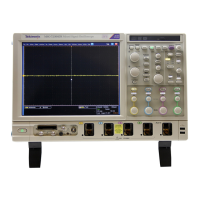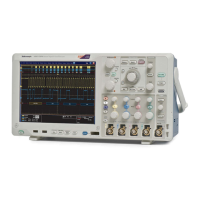T1 values. The T1 values are vertical and horizontal values associated with the left-most crossing point. These areas are used to
establish the following values:
■
TCross
1
Mean. This is the horizontal mean of the left-crossing point at TCross
1
.
■
TCross
1
Sigma. This is the horizontal standard deviation of the left-crossing point at TCross
1
.
■
TCross
1
Peak-to-Peak. This is the horizontal peak-to-peak deviation of the left-crossing point at TCross
1
.
■
PCross
1
Mean. This is the vertical mean of the left-crossing point at PCross
1
.
T2 values. The T2 values are vertical and horizontal values associated with the right-most crossing point. These areas are used
to establish the following directions:
■
TCross
2
Mean. This is the horizontal mean of the right-crossing point at TCross
2
.
■
TCross
2
Sigma. This is the horizontal standard deviation of the right-crossing point at TCross
2
.
■
TCross
2
Peak-to-Peak. This is the horizontal peak-to-peak deviation of the right-crossing point at TCross
2
.
DCD values. The duty cycle distortion (DCD) values are horizontal values associated with the right-most crossing point at 50% of
the eye height. These areas are used to establish DCD
pk-pk
, the horizontal peak-to-peak deviation of the left-crossing point at half
the height of the eye.
What do you want to do next?
Learn about communication triggering.
Go to mask testing setup overview.
Output
Saving and recalling setups
This instrument can save a number of different instrument setups for later recall, limited only by the space that you have to store
the setups.
By saving and recalling different setups, you can switch from setup to setup without having to first manually record your settings
and then manually set them. This capability is helpful when you want to:
■
Save and recall a setup that optimizes the instrument for displaying and analyzing a certain signal
■
Save a series of setups to help automate a procedure through recall of a sequence of saved setups as part of performing
the procedure
■
Save a setup for sharing with a second instrument
If you do not have an attached keyboard, you can still name setup files. The Save and Recall dialog boxes include a pop-up
keyboard that you can use with your mouse or the touch screen to enter the setup path name and file name.
The instrument excludes the following items when saving setups:
■
Channel waveforms and reference waveforms. Control settings (scale, position, and so on) are saved but not the waveform
data. Upon recall of the setup, the settings are applied, but the data is not restored.
■
Math waveforms. Control settings and the math expression are retained but not the waveform data. Upon setup recall,
however, the math waveform expressions are applied, but math waveform data is not restored.
■
User options stored in the Windows registry. These include all options set in the User Preferences control window.
■
If you want to save a waveform in a useful format for other applications, such as a spreadsheet, use the save or save as
function (see Saving and Copying Waveform Data).
Oscilloscope reference
DPO70000SX, MSO/DPO70000DX, MSO/DPO70000C, DPO7000C, and MSO/DPO5000B Series 741
